| THE UNCANNY CEPHALOPODS - PART II |
The hedgehog of the cephalopod world, this Cranchia scabra has a mantle completely covered in
tiny, multi-pronged teeth. When threatened, it withdraws its head into the mantle and puffs itself into
a tight, thorny sphere.
tiny, multi-pronged teeth. When threatened, it withdraws its head into the mantle and puffs itself into
a tight, thorny sphere.
| #10 - Cranchia glass squid |
| #9 - Firefly Squid |
Every year from March to May, Japan's Toyama Bay comes alive with the dazzling blue light of
millions, even billions of tiny bodies in the midst of a mating frenzy. While light production is hardly
unusual for cephalopods, Watasenia scintillans are thought to rely on it the most for
communication, and are the only known species of squid able to see in full color.
millions, even billions of tiny bodies in the midst of a mating frenzy. While light production is hardly
unusual for cephalopods, Watasenia scintillans are thought to rely on it the most for
communication, and are the only known species of squid able to see in full color.
| #8 - the Chambered Nautilus |
Millions of years ago, the seas were dominated by shelled cephalopods including both the subclass
Nautiloidea and subclass Ammonoidea, known to reach tremendous sizes. Only the nautiloids
survived complete extinction, and are represented by only six species alive today. Favoring cold,
dark waters between 100 and 300 meters below the sea's surface, they can survive for months
without food and are known to live for up to 20 years - literally ten times longer than most other
cephalopods. This slow metabolism is due in part to their energy-saving method of locomotion;
gases exchanged between the hollow chambers of the shell allow the animal to easily adjust its own
buoyancy.
These ancient creatures have more primitive, sucker-less tentacles than their relatives, but may
have over ninety at any given time. They not only prey on small animals but will scavenge the
discarded exoskeletons of recently molted crustaceans, maintaining healthy growth of their own
shell.
Nautiloidea and subclass Ammonoidea, known to reach tremendous sizes. Only the nautiloids
survived complete extinction, and are represented by only six species alive today. Favoring cold,
dark waters between 100 and 300 meters below the sea's surface, they can survive for months
without food and are known to live for up to 20 years - literally ten times longer than most other
cephalopods. This slow metabolism is due in part to their energy-saving method of locomotion;
gases exchanged between the hollow chambers of the shell allow the animal to easily adjust its own
buoyancy.
These ancient creatures have more primitive, sucker-less tentacles than their relatives, but may
have over ninety at any given time. They not only prey on small animals but will scavenge the
discarded exoskeletons of recently molted crustaceans, maintaining healthy growth of their own
shell.
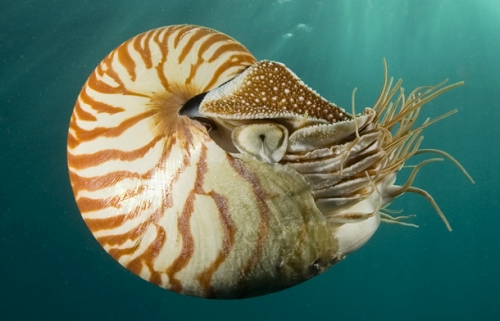
| #7 - Tremoctopus |
There are four known species of the Tremoctopus genus found off the coast of Australia, also
known as "blanket octopuses" after just one of their unusual adaptations. While many cephalopods
release a dark cloud of ink when attacked by a predator, female Tremoctopus unfurl a long,
billowing membrane of skin that may make them appear larger and more threatening or function as
a decoy body, easily tearing away without harm to the octopus itself. You may have noticed that I
specified females; this is because these animals exhibit sexual size dimorphism (males and females
of two different sizes) to the most extreme degree of any macroscopic (visible to the naked eye)
animal.
At up to and over two meters in length, females are roughly 100 times larger than the males, which
average little more than two centimeters and have developed an entirely different defensive tactic;
they are immune to the stinging tentacles of the Portuguese Man O' War, and will tear off tiny
pieces to carry in their suckers. They mate by leaving one of their own sperm-filled arms within the
female's body, and die shortly thereafter.
known as "blanket octopuses" after just one of their unusual adaptations. While many cephalopods
release a dark cloud of ink when attacked by a predator, female Tremoctopus unfurl a long,
billowing membrane of skin that may make them appear larger and more threatening or function as
a decoy body, easily tearing away without harm to the octopus itself. You may have noticed that I
specified females; this is because these animals exhibit sexual size dimorphism (males and females
of two different sizes) to the most extreme degree of any macroscopic (visible to the naked eye)
animal.
At up to and over two meters in length, females are roughly 100 times larger than the males, which
average little more than two centimeters and have developed an entirely different defensive tactic;
they are immune to the stinging tentacles of the Portuguese Man O' War, and will tear off tiny
pieces to carry in their suckers. They mate by leaving one of their own sperm-filled arms within the
female's body, and die shortly thereafter.
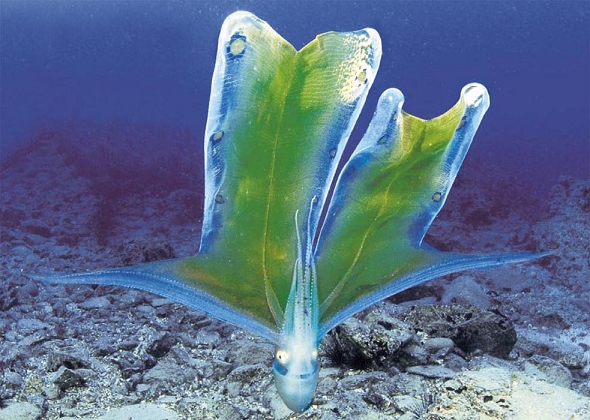
| #6 - Magnapinna Squid |
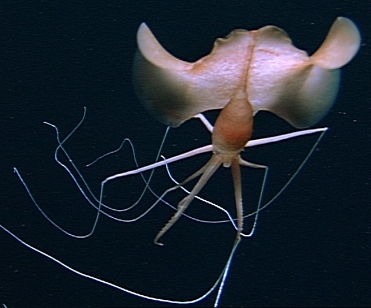
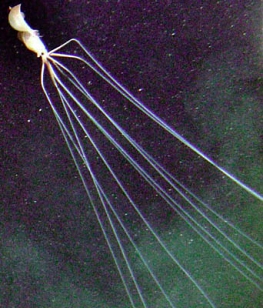
Discovered fairly recently, this unique deep-sea animal differs from other squid in having ten
appendages of identical shape and length. Drifting lazily in the open water, its stringy, trailing
appendages are held out by unusual "elbows" near the body and believed to snare whatever small
prey may blunder into them; a hunting technique closer to that of a jellyfish or spider.
Your mileage may vary, but in my honest opinion, our last five mollusks make the previous animals
look downright mundane...
appendages of identical shape and length. Drifting lazily in the open water, its stringy, trailing
appendages are held out by unusual "elbows" near the body and believed to snare whatever small
prey may blunder into them; a hunting technique closer to that of a jellyfish or spider.
Your mileage may vary, but in my honest opinion, our last five mollusks make the previous animals
look downright mundane...
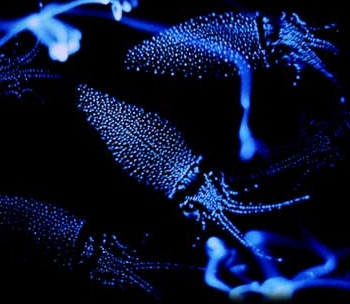
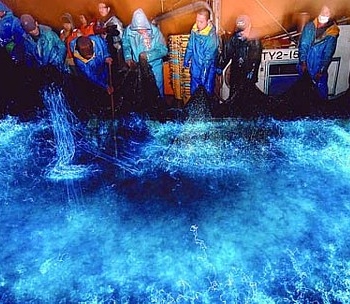
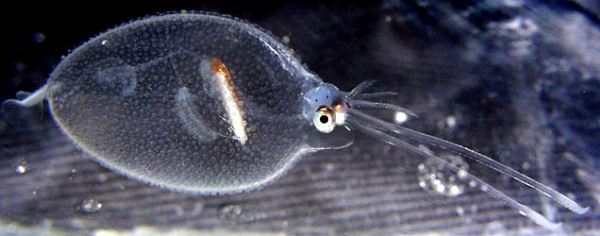
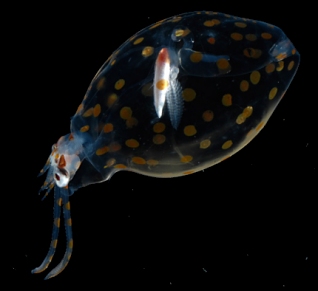
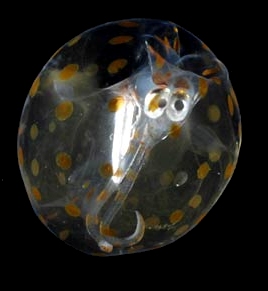
Similar species of Cranchiidae have their own distinct arrangement of spines, while some lack thorns
entirely. The adorable goofball above is a fairly recent discovery and a bit of an enigma, but may use
its polka dots in some way to confuse attackers.
entirely. The adorable goofball above is a fairly recent discovery and a bit of an enigma, but may use
its polka dots in some way to confuse attackers.
| Written by Jonathan C. Wojcik - Photo credits unknown or from public news outlets. |
| Counting down the fifteen most bizarre, most incredible mollusks in the sea, here's cephalopods 10-6! |
| Source: National Geographic |
| Source: Tolweb |
| Image copyright 2001 MBARI |
| Image from Tolweb |